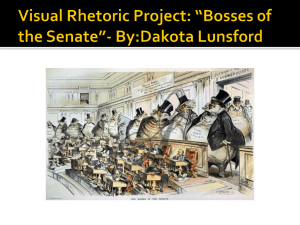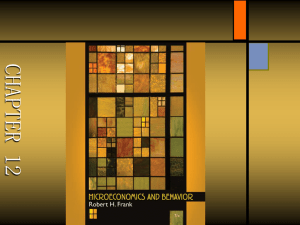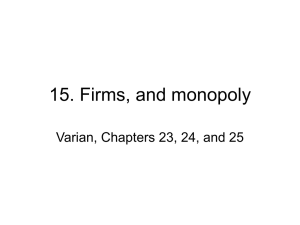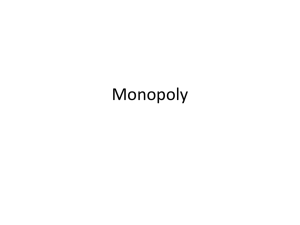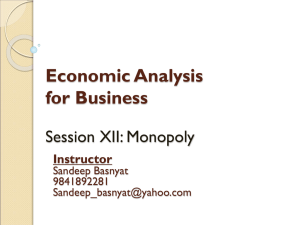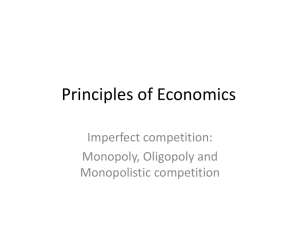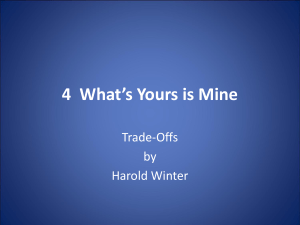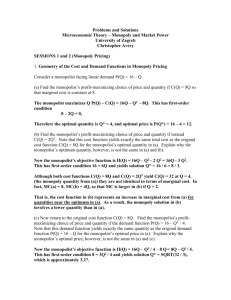PRICE DETERMINATION UNDER MONOPOLY
advertisement
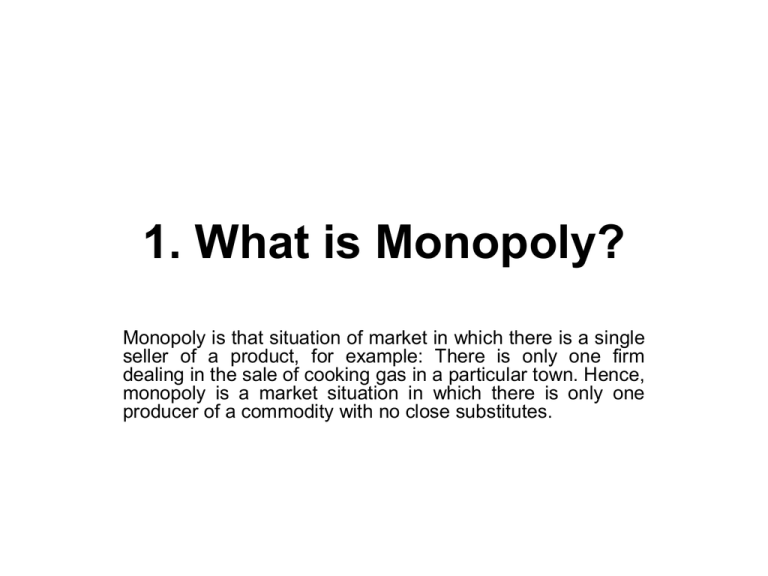
1. What is Monopoly? Monopoly is that situation of market in which there is a single seller of a product, for example: There is only one firm dealing in the sale of cooking gas in a particular town. Hence, monopoly is a market situation in which there is only one producer of a commodity with no close substitutes. 1.1 Definitions -According to Prof. Ferguson, “A pure monopoly exists when there is only one producer in a market. There are no direct competitors.” -Mc Connel says, “Pure or absolute monopoly exists when a single firm is the sole producer for a product for which there are no close substitutes.” 1.2 Features 1. 2. 3. 4. 5. One seller & large number of buyers: Under monopoly there should be single producer of the commodity. The buyers of the product are in large number. Consequently, no buyer can influence the price but the seller can. Monopoly is also an industry: Under monopoly situation, there is only one firm & the difference between firm & industry disappears. There is no difference between the study of a firm and industry. Restrictions on the entry of new firms: There are some restrictions on the entry of new firms into monopoly industry. There is no competitor o a monopoly firm. No close substitutes: The commodity produced by the firm should have no close substitute, otherwise the monopolist will not be able to determine the price of his commodity as per his discretion. Price maker: Price of the commodity is fully under the control of the monopolist. In case, the monopolist increases the supply of the commodity, the price of it will fall. If he reduces the supply, the price of it will rise. A monopolist may also indulge in price discrimination. In other words, he may charge different prices of the same product from different buyers. 2. Demand & revenue under monopoly In a monopoly situation there is no difference between firm & industry. Accordingly, under monopoly situation, firm’s demand curve also constitutes industry’s demand curve. Demand curve of the monopolist is also average revenue (AR) curve. It slopes downward. It means if the monopolist fixes high price, the demand will shrink. On the contrary, if he fixes low price, the demand will expand. Under monopoly, average revenue & marginal revenue curves are separate from one another. Both slope downwards. Following facts come to light as a result of negative AR & MR: i. Demand rises with fall in price (AR). Hence, by lowering the price, a monopolist can sell more units of the commodity. ii. AR is another name of price per unit, i.e., P=AR. iii. With fall in price, both AR & MR fall, but falling MR is more. Rate of fall in MR is usually more than rate of fall in AR. iv. AR is never 0, but MR may be 0 or even -ve. Fig.: Demand and revenue under monopoly 3. Determination of price and equilibrium under monopoly A monopolist will so determine the price of a product as to get maximum profit. A monopolist is in equilibrium when he produces that amount of output which yields him maximum total profit. A monopolist is also in equilibrium in the short period when he incurs minimum loss. Under monopoly, price & equilibrium are determined by 2 different approaches: 1. 2. TR & TC Analysis MR & MC Analysis 4. TR & TC curve analysis Monopolist can earn maximum profit by selling that amount of output at which difference between TR & TC is maximum. By fixing different prices or by changing the supply of the product, a monopolist tries to find out the level of output at which the difference between TR & TC is maximum, i.e., total profit is maximum. That amount of output at which a monopolist earns maximum profit will constitute his equilibrium situation. Fig.: Total revenue & total cost curve analysis 5. MR & MC analysis In case of monopoly, one can know about price determination or equilibrium position with the help of MR & MC analysis. According to this analysis, a monopolist will be in equilibrium when 2 conditions are fulfilled, i.e., 1. MC=MR 2. MC curve cuts MR curve from below. A monopolist earns maximum profit when he is in equilibrium. Price & equilibrium determination under monopoly are studied with reference to 2 time periods: A. Short period B. Long period Fig.: Marginal revenue & marginal cost analysis A. Price determination under short period or short-run equilibrium Short-run refers to that period in which time is so short that a monopolist cannot change fixed factors like: machinery, plant etc. Monopolist can increase his output in response to increase in demand by changing his variable factors. Similarly, when demand decreases, the monopolist will reduce his output by reducing variable factors & by slowing down the intensive use of fixed factors. A monopolist will face any of the 3 situations in the short period: 1. Super normal profit: If the price (AR) fixed by the monopolist in equilibrium is more than his AC, then he will get super normal profits. The monopolist will produce upto the extent where MC=MR. If the price of equilibrium output is more than AC then the monopolist will earn supernormal profit. 2. Normal profit: If in the short run equilibrium MC=MR, the monopolist price AR=AC, then he will earn only normal profit. 3. Minimum loss: In the short run, the monopolist may incur loss also. If in the short-run price falls due to depression or fall in demand, the monopolist may continue his production so long as the low price covers his AVC. A monopolist in equilibrium, in the short period, may bear minimum loss equivalent to fixed costs. In this situation, AR=AVC & the monopolist bears the loss of fixed costs. Fig.: Super normal profit Fig.: Normal profit B. Determination of Longrun or long-run equilibrium In the long run, the monopolist will be in equilibrium at a point where his long-run marginal cost is equal to marginal revenue. In the long run, because of sufficiently long period at the disposal of the monopoly firm, all costs can be varied & supply can be increased in response to increase in demand. Fig.: Determination of long run price or long run equilibrium Monopoly equilibrium & law of costs i. ii. 1) 2) 3) Elasticity of demand: If demand is inelastic, the monopolist will fix high price of his product. On the contrary, if the demand is elastic, the monopolist will fix low price per unit. Low price will not only extend demand & increase the sales, also maximize his profits. Effect of laws of costs on monopoly price determination: While fixing the price, a monopolist also takes into consideration cost of production. Diminishing costs: It means as production increases its cost per unit goes on diminishing. Increasing costs: It means as production increases, the cost of production also increases. Constant cost: It is a situation wherein cost of production remains constant, whether production is more or less. Price discrimination or discriminating monopoly Definitions: In the words of Koutsoylannis,“Price discrimination exists when the same product is sold at different prices to different buyers.” -Dooley,“Discriminatory monopoly means charging different rates from different customers for the same good or service.” Price & output determination or equilibrium under discriminating monopoly The aim of the monopolist in resorting to price discrimination is to increase TR & profit. Analysis of price determination under price discrimination can be made with reference to 2 or more market conditions. Each discriminating monopolist, in order to maximize his profit, will produce upto that level where MR=MC. In order to get maximum profit, 2 conditions must be fulfilled: 1.Get same MR in both markets: If we express MR of market ‘A’ as MR1, & MR of market ‘B’ as MR2, then MR of both the markets must be same, i.e., MR1=MR2. 2. Equality between MR & MC: Another condition of equilibrium is that MR earned in each market should be equal to the MC of the total output. If MR of market ‘A’ is expressed as MR1 & that of market ‘B’ as MR2, & marginal cost of total output as MC, then the condition of equilibrium will be written as: MR1=MR2=MC. Thank You

